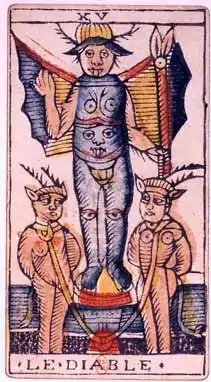The Devil (Tarot card)
The Devil (XV) is the fifteenth trump or Major Arcana card in most traditional Tarot decks. It is used in game playing as well as in divination.

Symbolism
According to A.E. Waite's Pictorial Key to the Tarot, the Devil card carries several divinatory associations:[1]
15.THE DEVIL--Ravage, violence, vehemence, extraordinary efforts, force, fatality; that which is predestined but is not for this reason evil. Reversed: Evil fatality, weakness, pettiness, blindness.
In the Rider-Waite-Smith deck, the Devil is derived in part from Eliphas Levi's famous illustration "Baphomet" in his Dogme et Rituel de la Haute Magie (1855). In the Rider-Waite-Smith deck, the Devil has harpy feet, ram horns, bat wings, a reversed pentagram on the forehead, a raised right hand and a lowered left hand holding a torch. He squats on a square pedestal. Two naked human demons (one male, one female) with tails stand chained to the pedestal. Levi's Baphomet has bat wings, goat horns, a raised right hand, lowered left hand, breasts and a torch on his head, and also combines human and animal features. Many modern Tarot decks portray the Devil as a satyr-like creature. According to Waite, the Devil is standing on an altar.[2] He is actually perched on a half-altar, or a half a cube, which shows he only knows half the story - the sensory half. Because of this, he can not make an informed decision.[3]
In pre-Eliphas Levi Tarot decks like the Tarot of Marseille, the devil is portrayed with breasts, a face on the belly, eyes on the knees, lion feet and male genitalia. He also has bat-like wings, antlers, a raised right hand, a lowered left hand and a staff. Two creatures with antlers, hooves and tails are bound to his round pedestal.

The card represents: Being seduced by the material world and physical pleasures; lust for and an obsession with money and power. Also: Living in fear, domination and bondage; being caged by an overabundance of luxury; discretion should be used in personal and business matters.

References
- Waite, Arthur Edward, 1857-1942. (2005). The pictorial key to the tarot. Mineola, NY: Dover Publications. ISBN 0-486-44255-1. OCLC 57549699.CS1 maint: multiple names: authors list (link)
- The Pictorial Key to the Tarot, by Arthur Waite
- Gray, Eden. "Complete Guide to the Tarot." 1970. Crown Publishers, New York, NY.
External links
| Wikimedia Commons has media related to Devil (Major Arcana). |